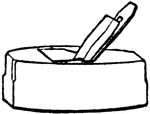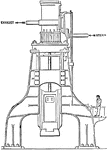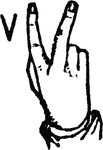
Left-Handed Rifle
"As additional instruction, the men may be permitted to wield the rifle left handed, that is on the…

Right Hang Rule
"Right hand rule to determine the direction of magnetic field around a conductor carrying a current.…

Right Hand Rule
"Right hand palm rule to determine the direction of the magnetic field around a conductor carrying a…

Right Hand Rule
"A rule for direction of induced current which in some cases, is more conveniently applied than Fleming's…
!["Fleming's rule for direction of induced current. Extend the thumb, forefinger and middle finger of the right hand [as shown]. Place the hand [so that] the thumb will point in the direction in which the conductor moves, the forefinger in the direction of the lines of force (N to S), then will the middle finger point in the direction in which the induced current flows." -Hawkins, 1917](https://etc.usf.edu/clipart/35600/35677/induc_35677_mth.gif)
Right Hand Rule of Induced Current
"Fleming's rule for direction of induced current. Extend the thumb, forefinger and middle finger of…

Right Hand Rule, Palm
"The palm rule for direction of induced current: If the palm of the right hand be held against the direction…
!["Right hand rule for polarity of a solenoid: If the solenoid be grasped in the right hand, so that the fingers point in the direction in which the current is flowing in the wires, the thumb extended will point in the direction of the north pole [of the solenoid]." Hawkins, 1917](https://etc.usf.edu/clipart/35600/35671/rhrsole_35671_mth.gif)
Right Hand Rule, Solenoid
"Right hand rule for polarity of a solenoid: If the solenoid be grasped in the right hand, so that the…

Hand seat
"Improvised Hand Seats: the Three-Handed Seat. THe usefull three-handed seat is made by one bearer grasping…

Hand seat
"Showing how the Improvised Three-Handed Seat may be used to carry an Injured Person. The picture also…
Sheet-metal Shears
"The ordinary sheet-metal shears merely resemble very powerful scissors, and, their action being quite…

Outer skin
"A Layer of the Outer Skin from the Palm of the Hand. Detached by maceration." — Blaisedell, 1904

Hand Sled or Sledge
"1. A drag or dray without wheels, but mounted on runners, for the conveyance of loads over frozen snow…
Hand Sled
"A pair of runners connected by a framework, used (sometimes with another pair) to carry loads or support…
Spoke-shave
"The spoke-shave affords a good example of what has just been said as to the result obtainable by a…

Squad
"Extend the arm horizontally toward the platoon leader; swing the hand up and down from the wrist."…

Demonstration of Static Electricity
A hand with bar demonstrating the attractive properties of static electricity.

Demonstration of Static Electricity
A hand with a rod, demonstrating the attractive properties of static electricity.

Stock
"The wood-worker's main stand-by for boring is the stock or brace and set of bits." — Encyclopedia…
Tail-vice
"The ordinary tail-vice used by mechanics has not yet been largely superseded, though many ingenious…

Round Front Primary Low Vowel
Vowels have a wide, firm, and free channel, whereby the breath is modified without friction or sibilation.…

Round Front Primary Mid Vowel
Vowels have a wide, firm, and free channel, whereby the breath is modified without friction or sibilation.…
Round Front Wide Low Vowel
Vowels have a wide, firm, and free channel, whereby the breath is modified without friction or sibilation.…

Round Front Wide Mid Vowel
Vowels have a wide, firm, and free channel, whereby the breath is modified without friction or sibilation.…

Round Mixed Primary Low Vowel
Vowels have a wide, firm, and free channel, whereby the breath is modified without friction or sibilation.…

Round Mixed Wide Low Vowel
Vowels have a wide, firm, and free channel, whereby the breath is modified without friction or sibilation.…

Normal Aperture Back Primary High Vowel
Vowels have a wide, firm, and free channel, whereby the breath is modified without friction or sibilation.…

Normal Aperture Back Primary Low Vowel
Vowels have a wide, firm, and free channel, whereby the breath is modified without friction or sibilation.…

Normal Aperture Back Primary Mid Vowel
Vowels have a wide, firm, and free channel, whereby the breath is modified without friction or sibilation.…

Normal Aperture Back Wide High Vowel
Vowels have a wide, firm, and free channel, whereby the breath is modified without friction or sibilation.…

Normal Aperture Back Wide Low Vowel
Vowels have a wide, firm, and free channel, whereby the breath is modified without friction or sibilation.…

Normal Aperture Back Wide Mid Vowel
Vowels have a wide, firm, and free channel, whereby the breath is modified without friction or sibilation.…

Normal Aperture Front Primary High Vowel
Vowels have a wide, firm, and free channel, whereby the breath is modified without friction or sibilation.…

Normal Aperture Front Primary Low Vowel
Vowels have a wide, firm, and free channel, whereby the breath is modified without friction or sibilation.…

Normal Aperture Front Primary Mid Vowel
Vowels have a wide, firm, and free channel, whereby the breath is modified without friction or sibilation.…
























